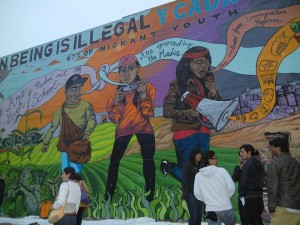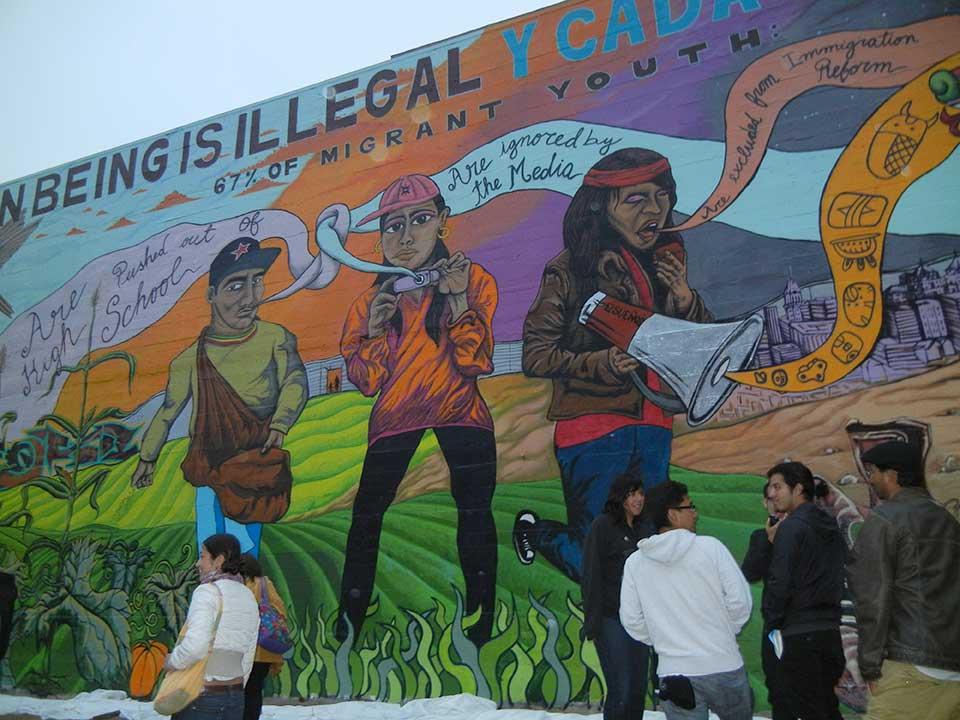 On August 26, just three blocks from San Francisco’s iconic City Hall, the veil was lowered from a 100-foot-wide, 30-foot-tall mural on the wall of the city’s Quaker Meetinghouse. Declaring “No Human Being is Illegal, y Cada Uno Tiene un Sueño” (and each one has a dream), the piece is the work of an immigrant-rights youth group called “67 Sueños” (67 Dreams) whose mission is to raise awareness of the plight faced by the estimated 67 percent of migrant youth who would not benefit from the provisions of the DREAM Act.
On August 26, just three blocks from San Francisco’s iconic City Hall, the veil was lowered from a 100-foot-wide, 30-foot-tall mural on the wall of the city’s Quaker Meetinghouse. Declaring “No Human Being is Illegal, y Cada Uno Tiene un Sueño” (and each one has a dream), the piece is the work of an immigrant-rights youth group called “67 Sueños” (67 Dreams) whose mission is to raise awareness of the plight faced by the estimated 67 percent of migrant youth who would not benefit from the provisions of the DREAM Act.
The center of the mural portrays three young migrant figures saying, “67% of migrant youth: are pushed out of high school; are ignored by the media; are excluded from immigration reform.” To their left are symbolic indigenous figures and animals who have gathered, dream-like, before rolling green fields. Moving to the right, a grey cityscape overtakes the green fields, the sky turns dark, and the nightmarish realities of migrant life take shape. A desert graveyard bears the names of some of the many who have died on the journey north or in custody of U.S. law enforcement. Looming behind is the image of the separation wall. One youth is pictured climbing over the fence, while an Immigration and Customs Enforcement (ICE) agent arrests another .
The mural evokes the dichotomy between dream and reality – the latter more akin to a waking nightmare. This dichotomy also captures the tensions around the DREAM Act itself.
Only Some Can Dream
Officially called the Development, Relief and Education for Alien Minors Act, the proposed DREAM Act would create a path to citizenship for undocumented youth under the age of 35 who entered the country before turning 16. But qualified candidates must complete high school or a GED program, and subsequently complete either a two-year college program or serve two years in the military. In May, the national DREAM Act failed to pass in the Senate by just 5 votes. Meanwhile, in California a state-level DREAM Act that gives some undocumented students increased access to private scholarship funding was enacted in July.
According to the recent documentary La Cosecha/The Harvest, only about one-third of migrant youth are able to complete high school. As many migrant families rely on seasonal agricultural labor for survival, they are forced into a nomadic lifestyle that requires the children of the family often need to work as well to make ends meet. Urban migrant youth face an equally daunting set of obstacles to completing high school. Depressed economic conditions and soaring unemployment push young people into the most lucrative inner-city industry – the drug trade. Between forced neighborhood gang inductions and constant police checkpoints, it is hard enough for these youth to survive, let alone make it through high school.
Right-wing pundits and politicians have denounced the DREAM Act as part of a vast minority-liberal conspiracy to disenfranchise white Americans. The Democratic Party and many progressives, meanwhile, have put the act on a pedestal as the best hope for immigrant rights in decades. But the subjects of this legislation – the migrant youths themselves – were never given the opportunity to voice their concerns. Under the slogan “nothing about us without us,” a group of seven mixed-status youth, along with Oakland-area youth organizer Pablo Paredes, launched 67 Sueños in the fall of 2010. Paredes describes the group as “a storytelling group, a media activist collective” seeking to address the absence of migrant voices in the immigration debate.
The right wing, Paredes explains, was evoking fear in the way they portrayed migrant people. “In response,” he continues, “the immigrant rights movement and a lot of the sympathetic media tried to fight back against that by only putting forth narratives of exceptional undocumented people: folks who had 4.0 averages in their high schools, kids who were valedictorians, the student body president at Fresno State. There were two polarized narratives out there but the majority of undocumented youth are somewhere in between.”
The group 67 Sueños is designed to change the culture and the content of those narratives.
Telling the Stories
In addition to the mural in San Francisco, the group is currently producing a documentary film project in which 67 undocumented youth will share their personal stories on camera. And invariably, “something will come up in every interview that does not just affect the individual, but is actually affecting tens of thousands if not hundreds of thousands of undocumented people in the country.” These three-minute videos are filled with relevant statistics and distributed as popular education tools amongst schools and rights groups.
Meanwhile, the group is also involved in solidarity activities in the immigrant communities in the Bay Area. In cooperation with a local women’s domestic workers union, the group holds regular “encuentros” (meetings) where youth can come to discuss their personal experiences in a safe setting. These encuentros have given the group growing mobilizing potential and have built confidence amongst area migrants to continue the struggle for recognition. Along with the Dreamer Movement, which hosts “coming out” events for undocumented students, 67 Sueños represents a promising upsurge from within the migrant community that will one day increase pressure on immigration policymakers.
For more information on the shortcomings of the DREAM Act, see this report by the Migration Policy Institute from December 2010. To see photos of the lighting-fast 20-day painting of the mural, see this slideshow courtesy of Pablo Paredes. 67 Sueños videos will be added to the YouTube channel linked above as they become available.

